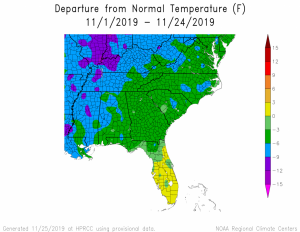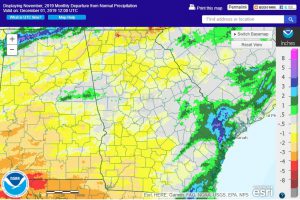November 2019 was 1-3 degrees F colder than normal, a stark contrast to the very warm October. Most areas of the state were drier than normal, but some coastal areas received heavy rain in mid-November, resulting in wetter than normal conditions there. In spite of the dry conditions across most of the state, drought coverage decreased during the month as impacts were limited following the end of the growing season in much of the state.
In Atlanta, the monthly average temperature was 52.5 degrees F (1.5 degrees below normal), in Athens 51.9 degrees F (1.9 degrees below normal), Columbus 54.9 F (2.4 degrees below normal), Macon 53.3 F (2.6 below normal), Savannah 56.6 F (2.7 below normal), Brunswick 59.4 F (2.4 below normal), Alma 55.6 F (4.3 below normal), Augusta 52.9 F (2.3 below normal), Albany 57.1 F (1.6 below normal), Rome 49.9 F (1.0 below normal), and Valdosta 57.6 F (2.3 degrees below normal).
Only a few daily records were set in November. Macon and Columbus reported record lows of 26 and 27 F, respectively, on November 13, breaking Macon’s old record of 27 F set in 2013 and Columbus’ old record of 28 F set in 1968. Alma tied their record high temperature on November 5, with 86 F, and set a record low maximum temperature on November 13, when they only got up to 49 F, breaking the old record of 50 F set in 2013. On the same date Brunswick only got up to 50 F, breaking their previous record of 52 F for that date from 1977. Savannah also tied their record low maximum on that date when it only got up to 50 F, as it did in 1920.
The highest monthly total precipitation from National Weather Service reporting stations was 6.19 inches in Savannah (3.82 inches above normal) and the lowest was in Alma with 1.37 inches (1.11 inches below normal). Atlanta received 2.68 inches (1.42 inches below normal), Athens received 2.14 inches (1.68 below normal), Columbus received 3.84 inches (0.26 inches below normal), Macon 2.89 inches (0.43 below normal), Augusta 2.62 inches (0.20 below normal), Brunswick 3.51 inches (1.48 above normal), Rome 2.79 inches (2.06 below normal), Valdosta 1.62 inches (0.94 below normal), and Albany 1.47 inches (1.72 inches below normal).
Two daily rainfall records were set in November 2019. On November 15 Alma received 0.76 inches, breaking the old record of 0.61 inches from 2006. On November 16, Savannah received 4.04 inches, smashing the old record of 1.38 inches set in 2002.
The highest daily rainfall total from CoCoRaHS observers was 6.30 inches one miles north of Pooler in Chatham County on November 16, followed by 6.02 inches measured east of Springfield in Effingham County on the same date. For the month, these two observers also had the highest totals, with 8.70 inches from the Pooler observer and 7.59 inches from the Springfield observer. No snow was reported in November.
Only one severe weather report was listed in November with a single damaging wind report on the last day of the month.
In spite of dry conditions across most of the state, severe drought decreased from 12.6 percent of the state covered to just 1.7 percent. Over 63 percent of Georgia is now completely drought-free. This is due to the combination of some heavier rain events which helped moisten the soil and the end of the growing season, which reduced water demands by many plants as they moved into winter dormancy.
Harvest for most crops is nearing completion and the increase in soil moisture allowed farmers to plant winter grains and forage in many areas. Some areas are still suffering from a lack of moisture and many livestock producers are continuing to feed hay due to the drought earlier this year.
The outlook for December and for the December through February period leans towards warmer than normal temperatures but equal chances for near, above and near normal precipitation. Neutral conditions are expected to continue in the Eastern Pacific Ocean through the next few months.
For more information please see the “Climate and Agriculture” blog at https://site.extension.uga.edu/climate. You can also visit the University of Georgia weather network web page at https://www.georgiaweather.net. Please feel free to email your weather and climate impacts on agriculture to share on the blog to pknox@uga.edu.


